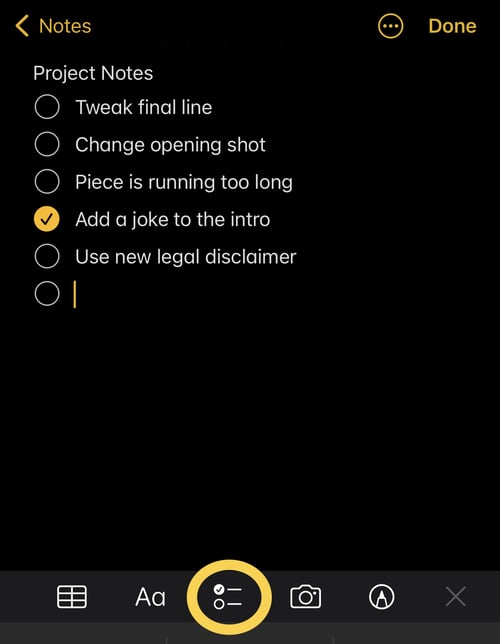
How to Receive Feedback Like a Creative Professional

Written by James Grosch
Feedback is one of the most important aspects of a creative partnership. I’ve already written about how to give great feedback that can elevate a project. Giving feedback is a valuable skill that every creative leader needs to have.
But receiving feedback is an equally valuable skill.
This might seem counterintuitive. Giving great feedback requires thoughtfulness, empathy, and deft communication. Receiving feedback should just be as simple as hearing what the other person has to say, right?
Wrong.
Being able to receive feedback well is an incredible asset to have as an artist. Over my career, I’ve worked on countless projects, and on each of these project I receive dozens of pieces of feedback.
Through my experience, I’ve learned how to hear notes and translate them into the results that my client is looking for.
Receiving feedback is a skill that I’ve improved over the years, and today I want to share a few of the lessons that any artist can use to up their feedback game.
1) Remove Your Ego
This can be extremely hard for some artists. If you’re like me as a creator, you pour part of yourself into everything you do. Your work is part of your identity, so receiving any negative feedback can feel like a personal affront.
Early in my career, I learned that this ego-centric view will not serve you as a creative professional.
Yes, it’s great to have tremendous pride in your work. And it can be hard to hear that something isn’t hitting the mark. But always have a project-first attitude. Think about everything through the lens of “Will this be the best idea for the project?” This will remove your personal feelings and give you more of an objective point of view.
Being egoless as an artist is about being generous to other people’s ideas. You have a lot to bring to the table as an artist, but you are not the sole decider in a creative partnership. Feedback is part of the job, and having an ego about it will just prevent you from doing your job well.
2) Always Give the Feedback an Honest Shot
Sometimes you’ll get a piece of feedback that will make you say “That won’t work.” Instead of instantly shooting it down, take a moment to really think through the feedback. Perhaps the feedback won’t work because the client is asking for something that is out of scope or budgetary unfeasible. That can happen.
However, I find that it’s always a good idea to think through every piece of feedback. Give it honest, serious consideration. The request might be impossible to pull off, but you might come up with a good alternative that gives the client what they want.
And you might end up surprised. Sometimes the feedback that you don’t think will work ends up actually being a great idea.
You owe it to your partners to take every piece of feedback seriously.
3) Don’t Just Be a Yes Person
Just because you should seriously consider every piece of feedback doesn’t mean you should instantly say yes to everything. Your creative partner is working with you due to your expertise in your field. And sometimes the feedback you get just won’t work. It could be a budget thing. It could be a tonal thing. It could be an artistic choice.
If you think that a note just won’t work after considering and exploring it, then you should speak up. Don’t just say yes to every single note that is thrown your way. Your creative partners are relying on you to bring your taste and opinions to the table.
This can be a balancing act, as having a strong opinion about every note will grind the creative process to a halt. Ask yourself if this change will be worth it to the project in the long run. Sometimes your creative instinct can be the thing that saves a project. But some hills aren’t worth dying on. Once again, view everything through the lens of “What is best for the project?”
4) Be a Problem/Solution Detective
Sometimes, you’ll receive a note that isn’t really about what it’s about.
Confusing? Yes. But let me explain further.
Your client could give you a note about a color seeming too dull. You try giving them a more vibrant color palette, and it’s still not working for them. You try 100 different color combinations, and nothing is working for the client. It’s because there’s a deeper underlying issue that isn’t just about color. In this scenario, the entire piece isn’t engaging them. They’ve focused on color, but it’s the color in combination with the animation or the sound design or the font choice.
If you’re running into issues where feedback is vague or multiple attempts at solving a note isn’t satisfying your client, you need to put on your detective hat. Ask yourself, “Is there a bigger issue going on here? What is the underlying cause to their reaction?”
Sometimes a client might have a hard time expressing exactly what’s not working. This can be frustrating, but you should be empathetic to them. They are just trying to figure out a problem, and they need your help to find the right solution.
5) Put Notes in a Bullet Point To-Do List
This is the most practical piece of advice I can give you for receiving feedback. If whoever gave you feedback read my first blog post, they already sent you every note for this revision in a single bullet point list. However, you will receive feedback in all sorts of forms, from notes over a Zoom call to an email with paragraphs full of notes.
In these cases, you do not want to miss anything that your client or director is requesting.
The first step for you is to translate these notes into an actionable to-do list. You can do this in any number of ways.

- I personally like using a task manager like Things or Omnifocus. I find these extremely helpful when tackling multiple projects or multiple scripts on a single project. My preferred method is to have the list of notes open in my task manager on my iPad while I work on the revisions. This way I can check off each note as I tackle them.
- Apple Notes is a great free option for to-do lists. Just click the check mark icon (shown above) while making a new note. If you use multiple Apple products, this option works well because your notes will sync between your Mac, iPhone, and iPad.
- You can always go old school with a notepad and pen or sticky notes.
Having each note broken down into a to do list will help you make sure you fully address everything the client wants on your current pass. Plus, it’s very satisfying to check off everything from the list.
Conclusion: How to Up Your Feedback Game
Remember to always do the following when receiving feedback from a client or a coworker:
- Remove your ego and ask “What is the best idea for the project?”
- Always seriously consider every piece of feedback, even if you initially won’t think it will work.
- Don’t just say yes to everything! Stand up for important decisions and voice your opinion when it matters.
- Look for creative solutions. Sometimes you’ll need to translate the feedback you’re receiving to find the real problem.
- Organize your feedback into an actionable to-do list.
For creative professionals, feedback is a part of life. Dealing with it well will mean that you bring more value to the table in any creative partnership. And if you find yourself in a position where you are leading a project, check out our post on the keys to giving effective creative feedback.
Topics: creative studio partnership
